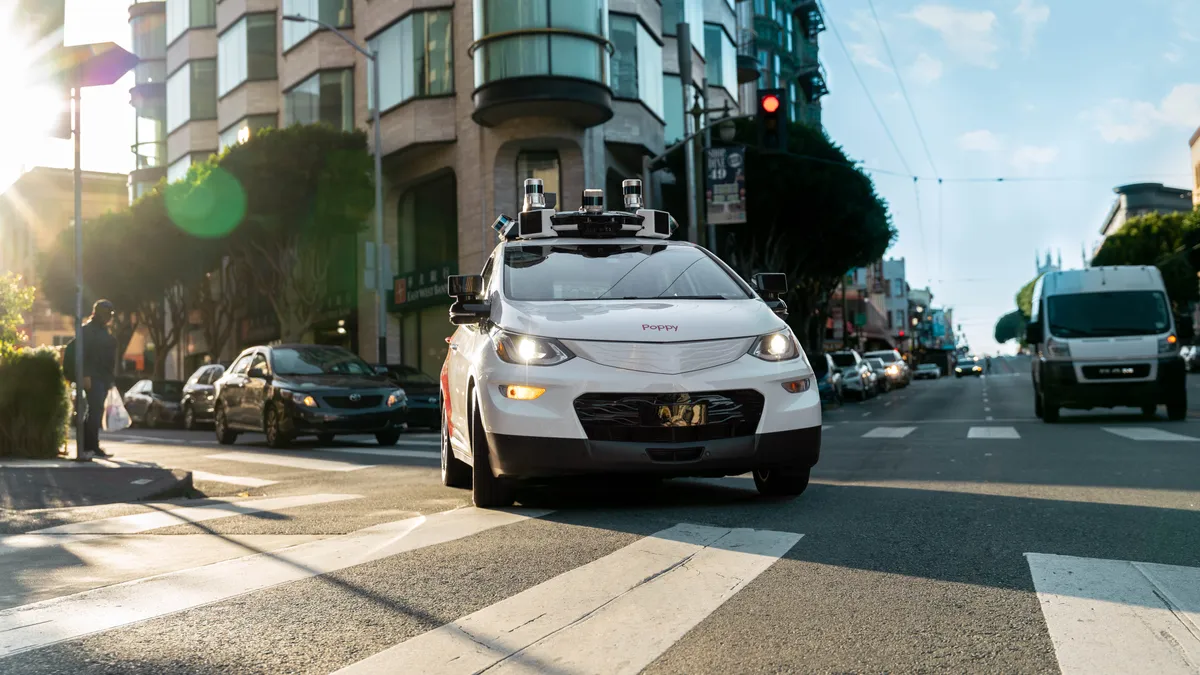Dive Brief:
- Automotive industry groups want the U.S. Department of Transportation to propose federal regulations that would make it easier for vehicle manufacturers to deploy autonomous vehicles on U.S. roads, according to a Thursday letter cosigned by 18 organizations, including the Alliance for Automotive Innovation, the Autonomous Vehicle Industry Association, the Consumer Technology Association and the U.S. Chamber of Commerce.
- The groups expressed support for the ADS-equipped Vehicle Safety, Transparency and Evaluation Program teased by Ann Carlson, acting administrator of the National Highway Traffic Safety Administration, during the Automated Road Transportation Symposium in July.
- NHTSA was supposed to publish its proposal in November, according to the White House’s Office of Management and Budget, but it has not.
Dive Insight:
Federal and state policymakers, including lawmakers and regulators, are beginning to view AVs with a more skeptical eye, which may slow AV deployment and adoption.
NHTSA began investigating Cruise, General Motors’ AV subsidiary, in December 2022 following several incidents whereby the company’s vehicles stopped moving, creating dangerous situations for passengers and other road users.
The agency’s investigation into the safety of Cruise’s vehicles expanded in October after one of its driverless robotaxis struck and severely injured a pedestrian in San Francisco.
The incident led the California Department of Motor Vehicles to suspend Cruise’s permit to operate and test driverless autonomous vehicles in the state, with GM halting Cruise Origin production in November. Cruise’s co-founder and former CEO Kyle Vogt resigned from the company shortly after that. By the end of November, GM CEO Mary Barra said the company would “substantially lower spending in 2024” on Cruise’s expansion.
Last month, 26 labor unions sent a letter to the Transportation Department and NHTSA demanding more federal oversight and investigations into AV companies.
Tesla is also dealing with numerous federal and state investigations related to its Autopilot and Full-Self Driving advanced driver assistance systems. On Tuesday, the automaker said it was recalling more than 2 million vehicles because of concerns about the safety of its Autopilot system.
Mercedes-Benz, meanwhile, became the first automaker to introduce an SAE Level 3 system for use on public roads in California after the state certified its Drive Pilot conditionally automated driving system in June.
States are mainly responsible for regulating self-driving vehicles under a 2016 guidance policy from the Transportation Department that has been updated several times, with the most recent update from the Trump administration in January 2021. According to the Insurance Institute for Highway Safety, more than 30 states permit EV testing or full deployment on their roads.
Standardizing those rules, however, might allow automakers to test and deploy vehicles nationwide.
In July, Carlson said greater AV deployment, as well as new safety and data requirements, would help automakers, researchers and policymakers learn more about the potential effects of AV use on public roads.
Under AV STEP, NHTSA would allow companies to apply to deploy noncompliant vehicles equipped with automated driving systems, such as those lacking mirrors, sun visors, windshield wipers and other equipment needed for human drivers. Operators could also apply for waivers involving compliant ADS-equipped vehicles if they believe participation would benefit them.
“By allowing the deployment of exempt ADS vehicles under conditions that include requirements to demonstrate safety and provide information about vehicle operation and deployment, we believe AV STEP would open up a wealth of data,” Carlson said. “We also believe the program would provide additional transparency about AV safety and deployment while giving the public assurance that NHTSA is overseeing the deployment of AVs on our public streets.”
In their joint letter, automotive industry groups said, “the AV industry is at a critical juncture and in need of strong leadership from USDOT,” arguing that greater AV deployment has the potential to improve road safety, transportation access and equity and freight transportation, as well as lower emissions.
The letter also appealed to the Biden administration’s desire to compete with and rein in China’s economic and industrial power.
“The U.S. stands at a critical juncture in the AV race, with countries like China aggressively investing and advancing the technology,” the letter says.
Federal lawmakers are also considering legislation to establish a nationwide regulatory framework for AVs.
More than 20 safety groups, however, urged lawmakers “not to advance legislation that will turn our Nation’s public roadways into private testing grounds and turn the public against this technology” in a letter addressed to the House Energy and Commerce Committee earlier this year.
“When developed and deployed with the appropriate safeguards and consideration of broader societal impacts, Automated Driving Systems have the potential to lead to better outcomes across the transportation system,” a DOT spokesperson said in an email.“However, these outcomes are not intrinsic or inherent to the technology. The net impacts – on safety, mobility, emissions, workforce and otherwise – will be the result of engineering, deployment, and policy choices.”













